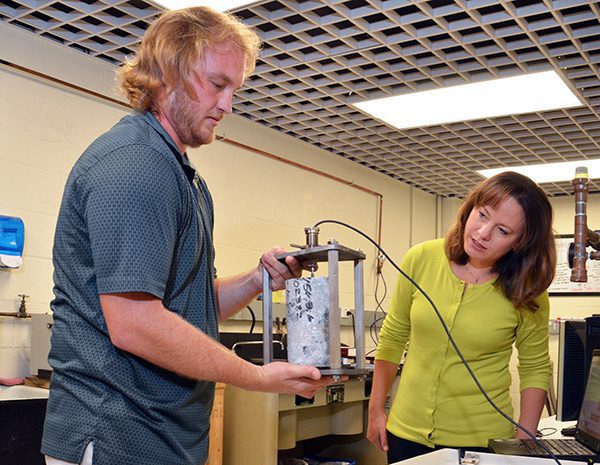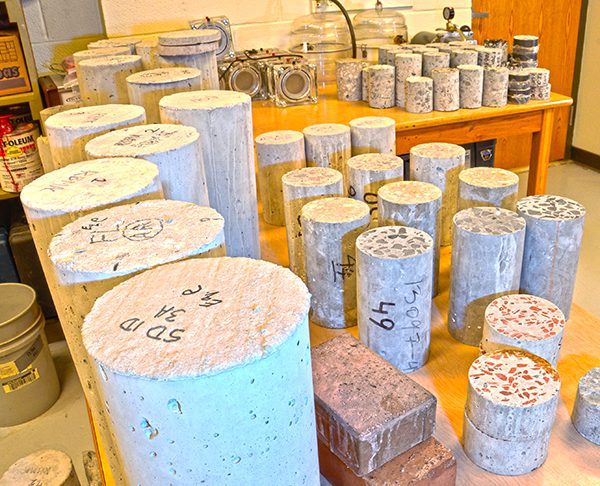Concrete Testing for Design of North Carolina Pavements

In an effort to improve economy, durability and smoothness of highway pavements, a new design procedure is being implemented nationwide. This procedure, outlined in the Mechanistic-Empirical Pavement Design Guide (M-EPDG), represents the work of leading researchers over the past two decades. Many federal and state agencies have adopted M-EPDG for pavement design, including the North Carolina Department of Transportation (NCDOT). Researchers in the Lee College of Engineering’s Engineering Technology and Construction Management Department are providing testing services for NCDOT to determine properties of concrete mixtures used in North Carolina highway pavements. These values will be used in design of new pavements and analysis of existing concrete pavements using M-EPDG.
The testing in the laboratory of Dr. Tara Cavalline is part of research work going on in the Construction and Facilities Management master’s degree program and the Civil Engineering Technology and Construction Management bachelor’s degree programs. Dr. Cavalline’s lab began testing concrete core samples for NCDOT in May 2013. The core samples come from three local projects, the I-485/I-85 interchange project, and two I-85 widening projects. The main property the lab is working to determine in its testing is the coefficient of thermal expansion (CTE).
“The coefficient of thermal expansion of concrete plays a key role in concrete pavement performance,” Dr. Cavalline said. “Higher values of CTE have been shown to contribute to premature pavement distress associated with cracking, slab curling and joint deterioration. The CTE is a very small value, on the order of micro-inches of length change per inch of material, per degree temperature change. But little changes add up very quickly over lengths of pavement.”
To determine this very important CTE value, Construction and Facilities Management graduate student Dallas Schwerin submerges the core samples in a water bath. He cycles the water temperature in the bath from 50°F to 122°F three times over a period of approximately 20 hours. Sensitive measuring devices record length changes and send the data to a computer.
“This equipment uses the water bath method, because it results in better control of the temperature of the test specimens,” Schwerin said. “We’re measuring very small length changes on the order of 10 to the minus 6th inches, which is a millionth of an inch or a micro-inch. The results we’re seeing are typically length changes of about 5 micro-inches per inch, per degree. Since we’re dealing with such small values, we have to repeat the temperature cycles to make sure our results are accurate.”
The CTE testing is part of Schwerin’s larger thesis research on the use of concrete, which includes recycled aggregates produced using construction and demolition waste. “I’m looking at the use of brick masonry from demolition sites as recycled aggregate in concrete,” he said. “This work with NCDOT and the Federal Highway Administration has been extremely valuable, because I get to see real-world materials in addition to experimental materials. The opportunity to interact with industry professionals to discuss results is also a great.”
In addition to testing concrete core samples for NCDOT, Dr. Cavalline’s lab is participating in a round robin study sponsored by the Federal Highway Administration (FHWA). This testing began in July. UNC Charlotte is one of 20 labs throughout the country participating in the study.

“It is a real honor to be picked by the FHWA to participate in this project,” Dr. Cavalline said. “We’re testing specimens prepared from concrete mixtures prepared using several different types of aggregates common in the United States. Our results are then compared to the results of other labs to evaluate the precision of this test method, AASHTO T336-11. The end result will be the development of a precision statement for the test method.”
To date, both the NCDOT and FHWA projects are going well. “NCDOT appreciates the data we’re providing and is pleased with our work,” Dr. Cavalline said. “They are trying to design and construct pavements for North Carolina that perform well over time. The values we are reporting will be used in their design procedures to help provide NCDOT more reliable predictions of the performance of future North Carolina concrete pavements.”
For more information contact Dr. Cavalline.